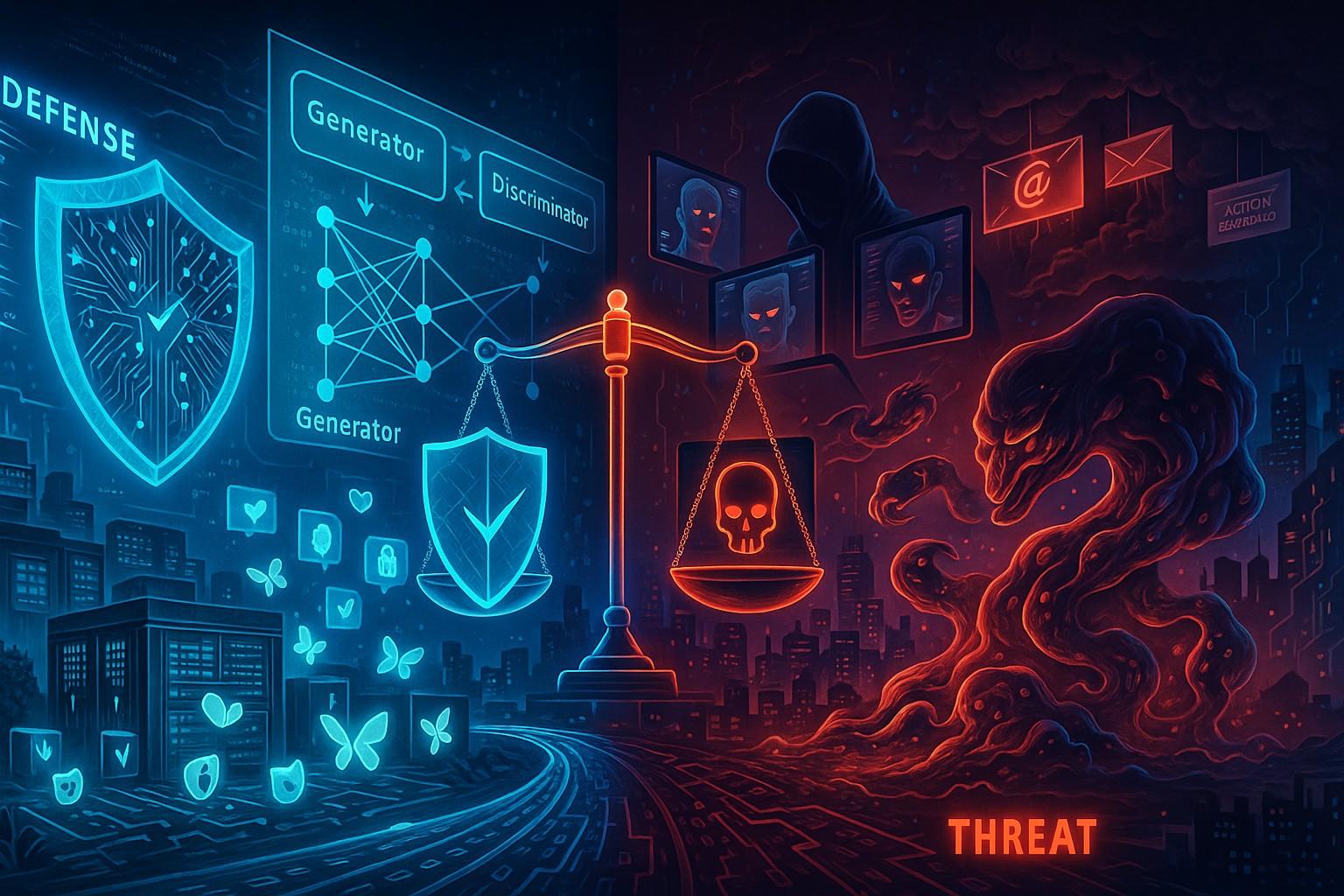1. Introduction to GANs and Cyber security
Generative Adversarial Networks (GANs), first proposed by Ian Goodfellow in 2014, have transformed the field of artificial intelligence by allowing machines to create new, lifelike data. Comprising two neural networks—a generator and a discriminator—GANs operate through a competitive learning framework. While GANs have made significant strides in areas such as image generation, text creation, and entertainment, their importance in the realm of cyber security is becoming more pronounced. GANs provide both significant obstacles and fascinating prospects as cyber threats become more complex and frequent. Understanding the connection between GANs and cyber security is essential for creating smart defenses and anticipating possible threats.
2. Enhancing Malware Detection
A significant area where GANs are aiding cyber security is in the detection of malware. Conventional antivirus and signature-based detection methods frequently have difficulty recognizing new or disguised threats. GANs assist in closing this divide by creating synthetic malware variants that resemble actual ones. These artificial samples can be utilized to train and assess detection models, enhancing their capacity to identify even threats that were not encountered before. Through the simulation of polymorphic and metamorphic malware, Generative Adversarial Networks (GANs) offer an ongoing supply of dynamic data, enabling machine learning systems to remain proactive against adversaries who frequently modify their code to evade detection.
3. Data Augmentation for Security Training
Cyber security datasets are frequently imbalanced—there are typically far more benign samples than malicious ones. This imbalance poses a challenge for training effective machine learning models. GANs offer a solution by generating high-quality synthetic malicious samples that augment existing datasets. With more balanced training data, AI systems become more capable of identifying rare or sophisticated attack patterns. This is especially valuable for developing intrusion detection systems (IDS), phishing classifiers, and fraud detection models, which rely heavily on the quality and diversity of the data they are trained on.
4. Realistic Attack Simulation
An additional significant use of GANs in the field of cyber security is for simulating attacks. Cyber security experts and penetration testers require realistic and reproducible attack scenarios to evaluate their defenses and response strategies. GANs are capable of producing synthetic network traffic that resembles genuine cyber attacks, such as Distributed Denial of Service (DDoS) attacks, data theft, or lateral movements within a network. Organizations can assess the performance of their intrusion detection and prevention systems (IDPS) in near-real scenarios with the aid of these realistic simulations. Additionally, they provide red teaming drills, in which defenders rehearse reacting to enemies in realistic settings without running the danger of sustaining real damage.
5. Phishing Detection and Adversarial Email Generation
Phishing continues to be one of the most prevalent and potent attack techniques. GANs can aid in identifying phishing attempts and in training systems to protect against them. GANs can be employed to strengthen email filters and NLP-based phishing detectors by creating fake phishing emails that closely mimic authentic ones. Additionally, these tools can be utilized to generate a collection of varied phishing messages, assisting security teams in enhancing their heuristics and pattern recognition methods. However, this ability also presents risks, as malicious individuals may leverage GANs to produce highly persuasive phishing content that evades conventional security protocols.
6. Deepfake Detection and Protection
Deep fakes hyper-realistic spoof audio or video snippets produced by GANs have major ramifications for cyber security, particularly in the context of social engineering. In audio or vedio calls deepfakes can be used to mimic executives, giving attackers the ability to conduct fraudulent transactions or influence stakeholders. Nonetheless, GANs can also serve a defensive purpose. For instance, they can assist in training deepfake detection systems by generating controlled artificial samples for examination. Researchers are creating GAN-driven watermarking and authenticity verification systems that assist in detecting altered media. As synthetic media becomes increasingly prevalent, differentiating between authentic and fabricated content will be essential for digital trust and cyber security
7. Adversarial AI and Threat Modeling
In cyber security, adversarial attacks entail modifying inputs (such as network traffic, system logs, or binary files) in order to trick detection algorithms; GANs are perfect for creating such adversarial examples, which can reveal flaws in current models. GANs are also playing a key role in the development of adversarial AI—systems made to test and break other AI models. Developers can strengthen their systems and increase their resilience by anticipating and addressing vulnerabilities. For instance, researchers can patch blind spots before attackers can take advantage of them by training a GAN to produce malware samples that are particularly made to avoid a machine learning-based antivirus engine.
8. Privacy and Anonymization
Maintaining user privacy while analyzing data is a major challenge in industries such as national security, healthcare, and finance. GANs help ensure privacy in machine learning by creating artificial datasets that preserve the statistical characteristics of real data while concealing personal information. This lets researchers and cyber security experts test algorithms and threat detection systems without risking sensitive information. Additionally, GAN-generated data can help teamwork in cyber security research between companies by giving anonymized but realistic data for joint analysis. However, there is still a need to evaluate if GAN-generated data could be reverse-engineered or used to guess the original data, which would create new privacy concerns.
9. GANs in Cyber Threat Intelligence (CTI)
Cyber Threat Intelligence (CTI) means gathering, studying, and sharing information about possible or current cyber dangers. GANs can help with this by creating threat situations and guessing how attackers might act. For instance, a GAN can learn from past attack data to create new possible attack methods that haven’t been observed before but are likely based on statistics.This assists security analysts in anticipating new threats and improving the distribution of defensive resources. Furthermore, GANs can improve threat correlation tools that connect seemingly unrelated events into a unified view of an active campaign, thereby enhancing situational awareness and decision-making.
10. Ethical Concerns and Future Outlook
GANs provide many advantages for cyber security, they also create significant ethical and security issues. The same abilities that help protect systems—like creating realistic malware or mimicking attacks—can be misused by bad actors to get around security measures or carry out more complex attacks. As GANs improve, they could be used to automate cyber attacks on a scale and accuracy that has never happened before. The dual-use aspect of GANs necessitates rigorous governance, transparency, and cooperation among governments, academia, and industry. In the future, GANs are expected to serve as both a vital defensive tool and a significant danger, making it crucial to comprehend and manage their use responsibly in the field of cyber security.
Conclusion
Generative Adversarial Networks (GANs) are becoming significant assets in the realm of Cyber Threat Intelligence (CTI), introducing a novel approach to threat modeling, simulation, and the formulation of defense strategies. By facilitating the creation of synthetic attack scenarios and forecasting potential threat vectors, GANs improve the scope and depth of intelligence collection. They bolster proactive defense strategies by mimicking adversarial behaviors that may not have yet been encountered in real-world scenarios, providing security teams with a tactical edge. When utilized carefully, GANs can greatly enhance the area of threat intelligence, improving the resilience, adaptability, and readiness of cybersecurity systems against future cyber threats. The challenge now is to stay ahead—using GANs for protection while creating systems tough enough to handle the very attacks they can also help create.
– Mrs. Sangeeta Singh, HOD
Computer Science Application, Madhav University

